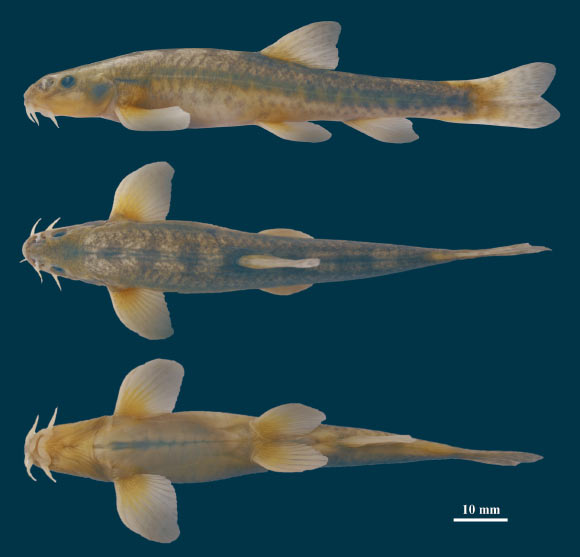A team of ichthyologists from China’s Southwest University has discovered a new species of the loach genus Triplophysa living in a high-altitude stream in Fergana Valley of Central Asia.

Left lateral, dorsal, and ventral views of the Fergana stone loach (Triplophysa ferganaensis), female, 8.75 cm standard length, Yordon village, Fergana Region, Uzbekistan. Image credit: Sheraliev & Peng, doi: 10.1111/jfb.14764.
The genus Triplophysa is one of the largest genera in the stone loach family Nemacheilidae.
It includes over 150 recognized species, most of which are distributed on the Qinghai-Tibet plateau and in adjacent areas.
Triplophysa species exhibit strong sexual dimorphism: mature males have breeding tubercles, elevated skin on both sides of the head in paired patches stretching from the lower margin of the eyes to the base of the outer barbel, and a thickened pad on the dorsal surfaces of the widened pectoral-fin rays.
Furthermore, their nostrils are situated close together, part of the bladder capsule is bony, and the bony bladder is dumbbell-shaped.
“Triplophysa are highland fishes that evolved along with the intense orogeny since the Miocene,” said Bakhtiyor Sheraliev, a Ph.D. student in the Key Laboratory of Freshwater Fish Reproduction and Development at the Southwest University School of Life Science.
“They are an ideal material for studying paleogeology and paleoclimate.”
Sheraliev and his colleague, Southwest University’s Professor Zuogang Peng, found a new Triplophysa species in the Shakhimardan stream in Yordon village, an exclave of Uzbekistan in Kyrgyzstan.
Named the Fergana stone loach (Triplophysa ferganaensis), the species is likely endemic to this high-altitude area.
It is threatened by spring flooding and overfishing, and cohabits with Schizothorax eurystomus, a typical high-altitude species of carp.
“The description of a new species of fish is a rare discovery in a region with a poor fish fauna, like Uzbekistan,” Sheraliev said.
“Specimens from the Triplophysa genus caught my attention during my fieldwork in Fergana Valley in 2019.”
“It was not possible to identify the sample at the species level on the site. At first, I thought I cannot identify them at the species level because of the complexity of Central Asian Triplophysa species taxonomy.”
“However, later long-term morphological and molecular analysis in the laboratory revealed that the specimens are of a new species that are not yet known to science.”
“The importance of our contribution is defined by the lack of taxonomic work on this taxon in the Central Asia area,” he added.
“In particular, no work on Triplophysa in the Syr Darya basin has been reported for the last seven decades. Thus, we hope our new finding fills some gaps.”
The team’s paper was published on April 26, 2021 in the Journal of Fish Biology.
_____
Bakhtiyor Sheraliev & Zuogang Peng. Triplophysa ferganaensis, a new loach species from Fergana Valley in Central Asia (Teleostei: Nemacheilidae). Journal of Fish Biology, published online April 26, 2021; doi: 10.1111/jfb.14764







